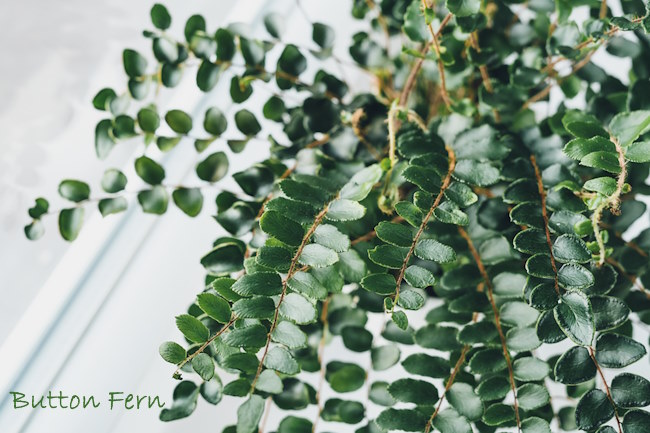Button Fern Care
Button fern care is simple. Much less demanding of humidity than most ferns, this handsome evergreen is downright easy to please indoors.
Arching fronds densely covered with small, round leaflets makes this New Zealand native an eye-catching accent for any brightly lit room. Place this fern on a plant stand among other tropical plants or put button fern in a hanging basket and allow the trail of leathery, button-shaped leaflets to cascade over the side.
 Give button fern plenty of bright, yet indirect sunlight year-round. Image © Chekyravaa
Give button fern plenty of bright, yet indirect sunlight year-round. Image © ChekyravaaGet to Know Button Fern Plant
Button fern is known botanically as Pellaea rotundifolia. It has shiny, round leaflets that grow in pairs along fuzzy, brown stems. Those leaflets darken as the plant ages, and will become more oval-shaped than round.
How big does button fern get? Stems will grow to 1 ft (30 cm) long. This fern tends to sprawl out rather than up.
Is button fern toxic to cats and dogs? No. According to the ASPCA, it's non-toxic and safe to keep indoors around your pets.
You may find Pellaea rotundifolia in garden shops in spring and summer, although it's not as easy to find as other types of ferns. If you come across this fern, buy it. With good care (it's easy) you'll enjoy it a long time.
Button Fern Problems, Solutions and Houseplant Helps
Repot in spring every 2 years, or when the roots have filled the pot. Move the fern to a pot that's 1- to 2-inches larger than the old one. Why? A pot that's too big for the plant will hold too much water. Use a pot with a drainage hole to prevent soggy soil. This is a good time to divide the fern, if you want.
Shed some light. Keep this evergreen in bright, indirect light and constant room temperature. It won't go dormant. With consistent care, it will grow year-round.
Brown leaf tips are caused by high temperatures (above 75°F/24°C) or dry air. Trim off dry leaflets and raise the humidity around your plant.
Yellow wilted fronds are a symptom of over-watering. One thing this houseplant won't tolerate is soggy soil, which leads to root rot. See "Water" tips below.
Watch for pests. Look over your houseplant for thrips, scale, and red spider mites. Isolate an infested plant and treat it right away; pests multiply quickly and will move on to your other indoor plants.
Button Fern Care Tips
Light: Bright light, but no direct sun
Water: Water thoroughly, then allow the top 1 in (2.5 cm) of soil to dry out before watering again. Button fern fronds that are yellow and wilted are a sign of overwatering. Cut back on water and trim off damaged fronds. Check the plant's roots to see if they have rotted -- if they're mostly black, get rid of it. It's too far gone.
Humidity: Moderate (around 50% relative humidity) year-round. Central heating can make indoor air extremely dry during the winter months. It's a good idea to use a humidity gauge near your houseplant, rather than guess. If the air is dry, raise the humidity around your fern with a room humidifier or set the plant on a wet pebble tray.
Temperature: Normal room (65-75°F/18-24°C). Keep button fern away from cold drafts and A/C and heat vents.
Soil: Good-quality houseplant potting mix with a handful of perlite or horticultural sand added to the mix to help drainage.
Fertilizer: Feed monthly year-round with a 20-20-10 water-soluble fertilizer at half strength.
Propagation: Division. In spring, divide the plant into 2 or 3 sections with a sharp knife and pot them up. Be sure to get roots with stems attached.


